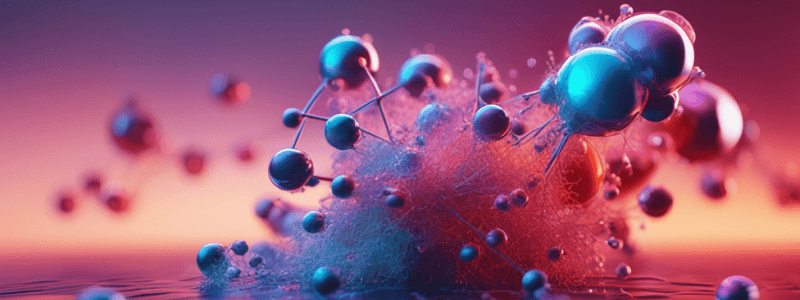Podcast
Questions and Answers
Which of the following best defines a free radical?
Which of the following best defines a free radical?
- A molecule with no electrons in its outer orbital
- A molecule that contains only even number of electrons
- A molecule or molecular fragment with unpaired electrons in its outer orbital (correct)
- A molecule with all paired electrons in its outer orbital
What are the products of partial reduction of oxygen that are highly reactive and create havoc in living systems?
What are the products of partial reduction of oxygen that are highly reactive and create havoc in living systems?
- Reactive oxygen species and hydroperoxyl radical
- Oxygen and lipid peroxide radical
- Superoxide anion radical and singlet oxygen (correct)
- Nitric oxide and hydrogen peroxide
What is the percentage of oxygen taken up in the body that is converted to free radicals during the normal oxidation of foodstuffs?
What is the percentage of oxygen taken up in the body that is converted to free radicals during the normal oxidation of foodstuffs?
- 15-20%
- 1-4% (correct)
- 25-30%
- 5-10%
Which of the following is NOT an important characteristic of reactive oxygen species (ROS)?
Which of the following is NOT an important characteristic of reactive oxygen species (ROS)?
What is the molecule that contains one or more unpaired electrons in its outer orbital called?
What is the molecule that contains one or more unpaired electrons in its outer orbital called?
Which reactive oxygen species is known for its extreme reactivity and short life span?
Which reactive oxygen species is known for its extreme reactivity and short life span?
What is the term used for the products of partial reduction of oxygen that create havoc in living systems?
What is the term used for the products of partial reduction of oxygen that create havoc in living systems?
Which of the following molecules has a short life span and causes damage to various tissues?
Which of the following molecules has a short life span and causes damage to various tissues?
What is the source of constant production of free radicals during the normal oxidation of foodstuffs?
What is the source of constant production of free radicals during the normal oxidation of foodstuffs?
What is the characteristic feature of lipid peroxide radical among reactive oxygen species (ROS)?
What is the characteristic feature of lipid peroxide radical among reactive oxygen species (ROS)?
What type of reaction ensures that molecular oxygen is completely reduced to water?
What type of reaction ensures that molecular oxygen is completely reduced to water?
What is the molecule or molecular fragment that contains one or more unpaired electrons in its outer orbital called?
What is the molecule or molecular fragment that contains one or more unpaired electrons in its outer orbital called?
What is the primary event during the initiation phase of lipid peroxidation?
What is the primary event during the initiation phase of lipid peroxidation?
Which type of anti-oxidants inhibit the initial production of free radicals?
Which type of anti-oxidants inhibit the initial production of free radicals?
Which anti-oxidant acts as a chain breaking anti-oxidant?
Which anti-oxidant acts as a chain breaking anti-oxidant?
What role do reactive oxygen metabolites play in degenerative brain disorders?
What role do reactive oxygen metabolites play in degenerative brain disorders?
What is the net result of reactions 2 and 3 during the propagation phase of lipid peroxidation?
What is the net result of reactions 2 and 3 during the propagation phase of lipid peroxidation?
Which anti-oxidant can act as an antioxidant in extracellular fluid?
Which anti-oxidant can act as an antioxidant in extracellular fluid?
Which anti-oxidant is used as a therapeutic agent?
Which anti-oxidant is used as a therapeutic agent?
Which type of anti-oxidants are uric acid and superoxide dismutase?
Which type of anti-oxidants are uric acid and superoxide dismutase?
What role do free radicals play in carcinogenesis?
What role do free radicals play in carcinogenesis?
Which enzyme is responsible for producing superoxide anion by a process of respiratory burst during phagocytosis?
Which enzyme is responsible for producing superoxide anion by a process of respiratory burst during phagocytosis?
What enzyme catalyzes peroxidation in platelets and leukocytes?
What enzyme catalyzes peroxidation in platelets and leukocytes?
Which enzyme reduces oxidized glutathione in the presence of NADPH?
Which enzyme reduces oxidized glutathione in the presence of NADPH?
What is the primary function of catalase when H2O2 is generated in large quantities?
What is the primary function of catalase when H2O2 is generated in large quantities?
Which enzyme is responsible for the removal of H2O2 by using glutathione peroxidase?
Which enzyme is responsible for the removal of H2O2 by using glutathione peroxidase?
What enzyme plays a role in the conversion of oxidized glutathione in the presence of NADPH?
What enzyme plays a role in the conversion of oxidized glutathione in the presence of NADPH?
Which enzyme is manganese dependent and its defect is seen in patients with amyotrophic lateral sclerosis?
Which enzyme is manganese dependent and its defect is seen in patients with amyotrophic lateral sclerosis?
What enzyme ensures the reduction of oxidized glutathione by using NADPH?
What enzyme ensures the reduction of oxidized glutathione by using NADPH?
Which enzyme is used for the removal of H2O2 when it is generated in large quantities?
Which enzyme is used for the removal of H2O2 when it is generated in large quantities?
Which enzyme ensures the reduction of oxidized glutathione by using NADPH?
Which enzyme ensures the reduction of oxidized glutathione by using NADPH?
Which enzyme is manganese dependent and its defect is seen in patients with amyotrophic lateral sclerosis?
Which enzyme is manganese dependent and its defect is seen in patients with amyotrophic lateral sclerosis?
What role does NADPH play in reducing the oxidized glutathione?
What role does NADPH play in reducing the oxidized glutathione?
Study Notes
- Dr. Reyad Hanano lectured on Free Radicals and Anti-Oxidants in the Department of Biological and Medicinal Chemistry at Al-Imam Muhammad Ibn Saud University.
- Free radicals are unstable molecules with unpaired electrons. They are byproducts of normal metabolic processes, but can also be produced by external factors such as radiation, tobacco smoke, and pollution.
- Reactive oxygen species (ROS) are a type of free radical. They include superoxide anion radical, hydrogen peroxide, hydroxyl radical, lipid peroxide radical, singlet oxygen, and nitric oxide.
- ROS are highly reactive and can damage various tissues in the body. They are constantly produced during normal metabolism, with about 1-4% of oxygen consumed in the body being converted to free radicals.
- Enzymes such as xanthine oxidase and aldehyde oxidase, inflammatory cells like neutrophils, eosinophils, monocytes, and macrophages, and platelets and leukocytes all contribute to the production of free radicals.
- Free radicals can be removed from the body by enzymes such as superoxide dismutase, glutathione peroxidase, glutathione reductase, and catalase. These enzymes work to neutralize free radicals and prevent damage to tissues.
- Damage caused by free radicals includes lipid peroxidation, which can lead to loss of membrane functions, damage to polysaccharides and DNA, and indirectly cause cell death or mutation and carcinogenesis.
- Free radicals play a role in various diseases, including chronic inflammatory diseases such as rheumatoid arthritis, acute inflammation, respiratory diseases, diseases of the eye, reperfusion injury, atherosclerosis and myocardial infarction, shock-related injury, skin diseases, carcinogenesis, and the aging process.
- Preventive anti-oxidants, such as catalase, glutathione peroxidase, and EDTA, inhibit the initial production of free radicals. Chain breaking anti-oxidants, such as superoxide dismutase, uric acid, and vitamin E, inhibit the propagative phase of free radical production.
- Vitamin E is a lipid-phase antioxidant, vitamin C is an aqueous-phase antioxidant, ceruloplasmin can act as an antioxidant in extracellular fluid, and caffeine is another effective antioxidant. Cysteine, glutathione, and vitamin A are also minor antioxidants.
Studying That Suits You
Use AI to generate personalized quizzes and flashcards to suit your learning preferences.
Related Documents
Description
Telegram channel : https://t.me/mcqb2




